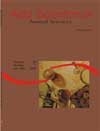<b>In vitro and in situ digestibility of three tropical forages collected manually and by esophageal fistulated cows</b> - DOI: 10.4025/actascianimsci.v30i2.4701
Keywords:
degradability, Napier grass, Colonião, Brachiaria
Abstract
This study evaluated in vitro (IV) and in situ dry mater (DM) digestibility, as well as in situ crude protein (CP), neutral (NDF) and acid (ADF) detergent fiber, cellulose and hemicellulose degradability of Colonião (Pannicum maximum) (COL), Brachiaria decumbens (BRACH), and Napier (Pennisetum purpureum) (NAP) grasses. The grasses were collected manually and from esophageal fistulated cows. The IV-DM digestibility of the manually collected samples were 64% for NAP, 63% for BRACH and 55% for COL. The insoluble potentially degradable fraction (%) and the degradation rate (% h-1) of NAP, BRACH and COL grasses were 62.8 and 6.4, 64.7 and 5.0, and 65.7 and 4.0 for DM; 62.0 and 4.2, 62.6 and 3.0, and 70.8 and 2.6 for CP; 77.2 and 6.3, 75.5 and 4.9, and 70.1 and 3.7 for NDF, respectively. It was concluded that forage availability was adequate and allowed forage selection by cattle, as the selected diet was more nutritive than the manually collected grass. For pasture systems with variable animal weight per hectare, Napier grass had higher digestibility, followed by Brachiaria and Colonião, which showed the lowest degradation values.Downloads
Download data is not yet available.
Published
2008-08-07
How to Cite
Benedetti, E., Rodríguez, N. M., Campos, W. E., Gonçalves, L. C., & Borges, I. (2008). <b>In vitro and in situ digestibility of three tropical forages collected manually and by esophageal fistulated cows</b> - DOI: 10.4025/actascianimsci.v30i2.4701. Acta Scientiarum. Animal Sciences, 30(2), 203-210. https://doi.org/10.4025/actascianimsci.v30i2.4701
Issue
Section
Ruminant Nutrition
DECLARATION OF ORIGINALITY AND COPYRIGHTS
- I Declare that current article is original and has not been submitted for publication, in part or in whole, to any other national or international journal.
The copyrights belong exclusively to the authors. Published content is licensed under Creative Commons Attribution 4.0 (CC BY 4.0) guidelines, which allows sharing (copy and distribution of the material in any medium or format) and adaptation (remix, transform, and build upon the material) for any purpose, even commercially, under the terms of attribution.
Read this link for further information on how to use CC BY 4.0 properly.
0.9
2019CiteScore
29th percentile
Powered by 








































